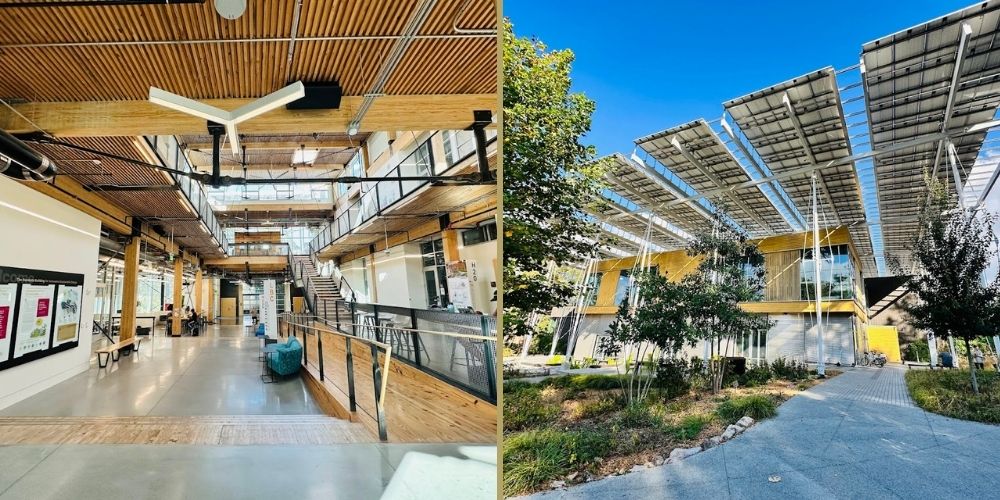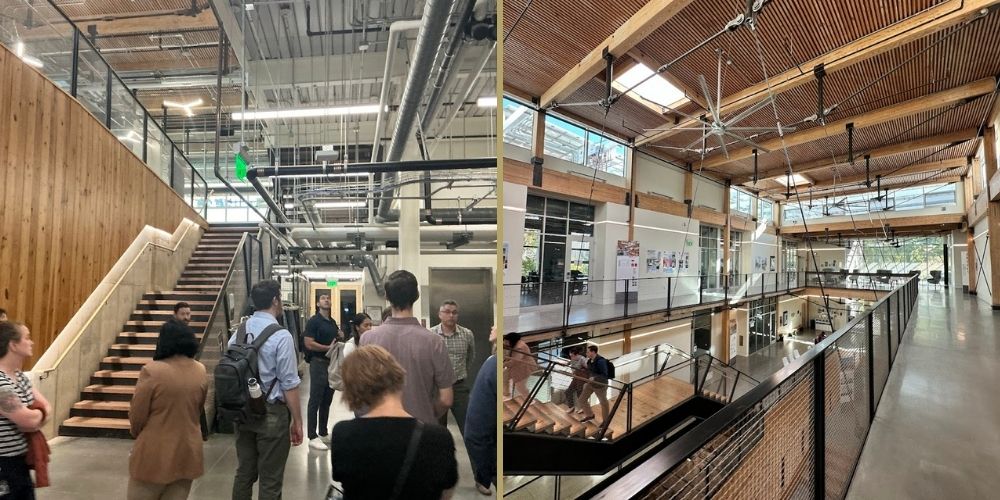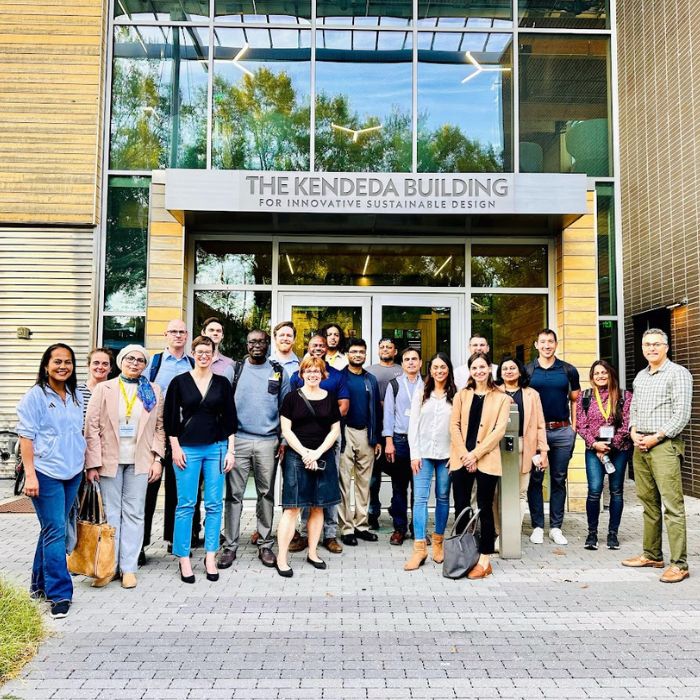Arezou Shafaghat, is an Executive MBA candidate at the Georgia Tech Scheller College of Business, an architect, urban planner, and civil engineer. She reflects on her experience visiting the Kendeda Building for Innovative Sustainable Design as part of the Business Strategies for Sustainability course. The course, led by Professor of the Practice Michael Oxman and Associate Professor Andre Calmon, introduces leading business practices and strategic sustainability, equipping students with tools to analyze, enhance, and implement sustainable business models.
On November 8, 2024, EMBA students had the opportunity to tour Georgia Tech’s Kendeda Building for Innovative Sustainable Design. It is the first building in the Southeast to earn Living Building Challenge certification – the world’s most ambitious green building achievement. The Kendeda Building is regenerative. Over the course of a year, it collects and infiltrates into the ground 15 times the amount of water needed for operations. Its solar panels supply over 200% of the building's energy needs. It gives back more than it takes from the environment and focuses on the health and happiness of occupants. In short, The Kendeda Building represents a paradigm shift regarding how we design and operate buildings. The tour, led by Shan Arora, the building’s director, highlighted the advanced green and energy-efficient building innovations. The tour also underscored the unique contributions MBA professionals can bring to such projects. As Shan guided us through the building, it became clear that every design choice was not only functional but also part of a broader sustainability strategy supported by sound scientific and financial reasoning. The tour shed light on the numerous ways that MBA professionals may support energy-efficient building design and construction, making them both commercially and ecologically viable.
In the front entrance of the Kendeda Building, our group saw the pervious pavers and concrete. This material, unlike conventional concrete, enables rainfall to seep through it, decreasing surface runoff, replenishing groundwater, and promoting more effective stormwater management. MBA specialists can calculate the financial savings associated with less need for stormwater management and present these results in cost-benefit assessments. The ability to clearly communicate the economic and environmental advantages of such systems to stakeholders can help the building receive funds or subsidies for environmentally friendly infrastructure.

Inside the building, I was struck by the use of mass timber wood for the building’s frame. This renewable alternative to conventional materials like steel and concrete actively stores carbon, which lowers the carbon footprint of building construction. To help create a healthy indoor air quality, all adhesives, paints, and finishes used on wooden components were carefully chosen to be non-toxic with zero formaldehyde. By figuring out carbon offsets and evaluating lifespan costs, MBA experts may be instrumental in promoting sustainable materials. MBAs can guarantee ethical sourcing and present a strong argument for green materials by collaborating with sustainable forestry suppliers.
The building’s rainwater collection and recirculation system is yet another noteworthy feature. Through the collection and purification of rainwater, this system will offer a sustainable supply of potable water (the system is undergoing final testing and will soon be operational). The composting toilets consume minimal water and handle waste in an environmentally friendly manner. Without a doubt, water conservation is becoming more and more important in the construction of green buildings, and MBA specialists can help to ensure that such systems are financially feasible. MBAs can show the long-term return on investment of these systems by estimating possible savings from lower water consumption and using financial models to offset installation cost. Additionally, they may assist in measuring how these systems affect operational costs, confirming their significance in reaching both financial and sustainability goals.
Another eco-friendly aspect of the Kendeda Building is passive ventilation. The system improves airflow and lowers reliance on mechanical HVAC systems. Strategically placed windows and vents efficiently supply healthy air, which proved to be especially helpful during the COVID pandemic. The business case for passive ventilation can be strengthened by involving MBA specialists’ assessment of energy savings and computation of the payback period associated with reduced HVAC consumption. Their insights may also assist in communicating these advantages to a building’s owner and users. Enhanced air quality, health advantages, and comfort are key factors that increase the building’s market attractiveness and occupancy rates.

MBAs Can Drive Sustainable Design and Long-Term Value
This tour underscored the value of MBA experts’ involvement in energy-efficient building design and construction. Due to their complex systems and materials, green buildings sometimes have higher upfront costs. MBA experts may contribute financial skills to make these investments feasible. MBAs may help close the gap between economic viability and environmental aims through finance mechanisms including tax incentives, public-private partnerships, and green bonds. MBAs’ proficiency in risk management is also crucial. By developing strong risk mitigation strategies, MBAs can reassure stakeholders and investors of the dependability of sustainable initiatives. Because they can convey the benefits of sustainable features, MBAs can foster alignment among all stakeholders, including architects, landscape architects, engineers, developers, tenants, clients, and community representatives.
Furthermore, via resource planning and strategic maintenance, MBA specialists may contribute significantly to lifecycle management and operational efficiency, guaranteeing that green buildings continue to be economical and sustainable over time. To build on this, they also negotiate regulatory and policy incentives, matching projects with sustainability-oriented policies to obtain more financing.
Powering Green Innovation Collaboratively
The greater upfront expenses of green design can be addressed by MBAs through financial strategy and economic planning. Creative funding techniques can show the sustainable projects’ long-term economic advantages. These projects frequently contain intricate ecosystems that call for thorough risk evaluations to convince stakeholders and investors of the building’s dependability. Therefore, MBAs’ proficiency in risk management is also important. MBA professionals will be adept at engaging stakeholders and uniting diverse organizations via transparent communication and agreement on common sustainability objectives. They can successfully communicate to renters, customers, and the general public the observable advantages of sustainable features, boosting support and enhancing the project’s branding. Without a doubt, by creating long-term operation, maintenance, and resource management plans, MBA knowledge in lifecycle planning and operational efficiency can guarantee that green buildings maintain their environmental effect and economic viability throughout their life cycle.
MBA specialists have the power to open the door to more sustainable structures like the Kendeda Building.

About the Author: Arezou Shafaghat, Ph.D., LEED Green Associate, and Executive MBA candidate at Georgia Tech, is an academic, editor, and researcher with over a decade of experience in entrepreneurship research, focusing on sustainable construction, urban design, energy efficiency, and data-driven decision-making. Her work has been supported by multiple research grants and cited in major projects funded by organizations such as the European Commission, NSF (National Science Foundation), and DOE (US Department of Energy). Shafaghat’s research has contributed to the development of several award-winning products. She is committed to bridging empirical research with entrepreneurial and sustainable solutions, driving impactful advancements in her field.
Photos: Courtesy of Hang T. Nguyen, student in the Executive MBA program.
